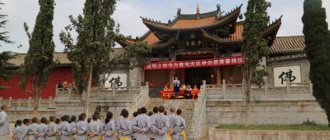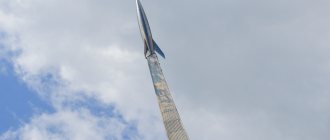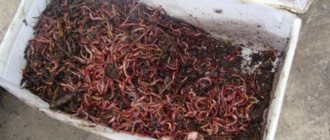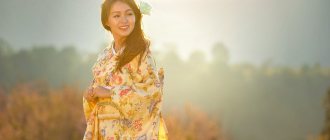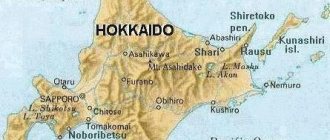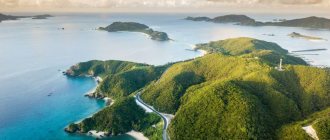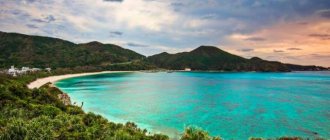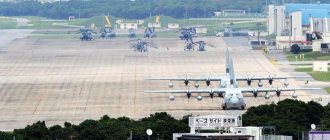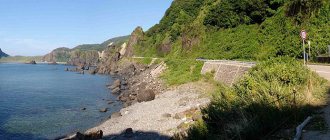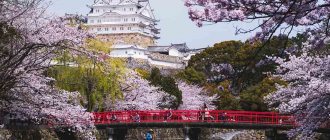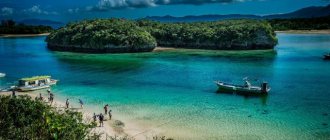brief information
The total area of the archipelago is 4,700 square meters. km, and the last population census, conducted back in 2005, identified more than 1.5 million people. However, of the nearly hundred islands that make up the Ryukyu, only half are suitable for habitation. Approximately 90% of the population lives on the largest of them, called Okinawa. This is due to the fact that the capital and economic center of Ryukyu, the city of Naha, is located on it.
On larger islands, mountainous terrain predominates, while on smaller islands, plains and low coastal terraces are more common. The Ryukyu Islands pose some danger to the population due to the large number of active volcanoes. This is especially true in the northern part of the archipelago, where the last major eruption occurred in 1991.
Atlas, Cities and countries, seas and oceans. Around the World, Mysteries of the 20th century, The whole world is in your hands
These volcanic and coral islands are a special region of Japan: they are 99 percent inhabited by Ryukyusans - a people related to the Japanese, who have a very ancient, distinctive culture - who speak their own language, incomprehensible to the Japanese. It is interesting that the Ryukyu state passed to Japan only at the end of the 19th century. Nowadays, a special dialect of Japanese is widespread as the main language.
RYUKYU ISLAND STATE
Around 1200, the unification of the Ryukyu feudal lords began, two centuries later creating the Ryukyu state, which lasted until 1879.
Ryukyu (Nansei) is an archipelago in the Pacific Ocean within Japan, consisting of 98 islands. Less than half of the islands (47) are inhabited.
The Ryukyu Archipelago consists of several distinct groups of islands that arc from northeast to southwest between the islands of Kyushu and Taiwan. The Japanese themselves attribute to the Ryukyu Islands only the middle and southwestern parts of the island arc, consisting of 55 islands with an area of 2.4 thousand km2
Those of the islands that are larger, as a rule, are of volcanic origin, hilly or mountainous in relief, dominated by plateaus and lowlands with a height of 300-500 m, as well as low coastal terraces. In some places, chains of coral reefs stretch along the coasts of large islands. The smaller islands are flat and of coral origin. In the northern part of the archipelago, the islands are home to volcanoes, some of which are still active. The most recent large eruption on the Ryukyu Islands occurred in 1991. East of the Ryukyu Islands in the Pacific Ocean stretches the deep-sea Ryukyu Trench, 7507 m deep.
Due to the peculiarities of the geographical location of the islands and geological processes in the region, the quiet life of the islanders is interrupted by powerful typhoons, earthquakes and tsunamis.
The nature of the islands is rich and colorful: the slopes of the mountains of the southern islands are covered with tropical forests with palm trees and orchids, while forests of camellias, magnolias, camphor laurel, and oak are preserved on the northern islands.
The islands are not rich in mineral resources (there are deposits of phosphorites and coal), but the fertile tropical climate contributes to successful agriculture: rice, sweet potatoes, sugar cane, and pineapples are grown on the islands. Intensive fishing is carried out in coastal waters.
The name of the Ryukyu Islands has Chinese roots; it was first mentioned in the Chinese historical work “Book of Sui” from 607 and translated as “Horned Lacquered Dragon”.
The “horns” presumably refer to the volcanic cones, the “lacquered” refers to the rich nature of the islands, and the “dragon” itself refers to the chain of islands itself, curved in the ocean.
The Ryukyu Islands began to be settled more than 30 thousand years ago. The first settlers came from mainland China, as well as from Micronesia and the Japanese Islands. The first known culture on the islands is the “shell hill culture”, which appeared 4 thousand years ago under the influence of the inhabitants of Micronesia.
Gradually, a feudal society emerged on the islands; Around 1200, the feudal lords of the previously warring clans united, and by the 15th century. created the island state of Ryukyu. The state flourished, being away from the feudal wars on the Japanese Islands. The Japanese conquered the islands in the 17th century, although the Sho dynasty that ruled the islands formally existed until 1879. Then Japan liquidated the island kingdom and created Okinawa Prefecture on the islands.
During World War II, the Ryukyu Islands saw one of the largest battles in the Pacific theater. After the end of the war, American administration was established on the island of Okinawa, part of the Ryukyu Archipelago. Currently, American troops are stationed in Okinawa, particularly at Kadena Air Base.
The Ryukyu Islands are located in a seismic zone, and from time to time the archipelago is shaken by earthquakes, usually occurring under water. In ancient Japanese literature, the Ryukyu Islands are often compared to a war bow with a drawn string. In 1945, during the Battle of Okinawa, the island was captured by American troops, and American military bases were established here. The presence of US military forces on the island is causing heated protests among Japanese residents.
LEGACY OF THE SECOND WORLD
To this day, large US military bases remain on the island of Okinawa, the largest of the Ryukyu islands.
Of the total population of one and a half million Ryukyu Islands, almost 90% live on the largest island - Okinawa. Here is the city of Naha, the capital and economic center of Okinawa Prefecture, and in fact of all the Ryukyu Islands, despite the fact that several northern islands belong to Kagoshima Prefecture with the capital of the same name on the island of Kyushu. Few historical sites remain here because during the Battle of Okinawa (April 1 - June 23, 1945), the city was almost completely destroyed, and Shuri Castle, now a UNESCO World Heritage Site, was reduced to ruins. The city was completely restored, and in 2013 it was given the status of a Central City, i.e., part of the powers of the prefectural level was transferred to local authorities.
More than 99% of the inhabitants of Ryukyu are a special nationality of the Ryukyus, differing from the Japanese not only in language, but even in physical type. Communities of Chinese and Indonesians also live on the islands.
Residents of the Ryukyu Islands speak a special dialect of Japanese. In official speech, the islanders use literary Japanese, and their native language is gradually giving way to it.
American military bases have remained on the Ryukyu Islands since World War II. There are 54 of them on the islands.
About 10 thousand American Marines are stationed on the island of Okinawa. The Japanese's attempts to get rid of the American bases lead nowhere, since the Americans demand that they be given equal territory in return, to which the Japanese refuse.
Another area of tension in the Ryukyu Islands area is the Senkaku Islands. According to its geographical location, this archipelago in the East China Sea belongs to the Ryukyu Archipelago. The Senkaku Islands are the subject of a long-standing territorial dispute between Japan, the Republic of China (Taiwan), and the People's Republic of China. For a long time, both Chinas did not object to Japan considering them theirs, until oil and gas were discovered here in 1968. Since then, warships of three countries have been constantly plying here, without yet entering into open conflict.
The main historical attraction of the Ryukyu Archipelago is the Gusuku Fortress, listed as a UNESCO World Heritage Site. They began to be built around the 12th century, and they served simultaneously as a place of worship of the gods, a fortified ancestral home and a feudal castle.
But the main thing that attracts guests to the Ryukyu Islands is the clear water (visibility up to 40 m) and coral islands. Okinawa's coastal waters are home to more than 200 species of reef-building corals and more than 1,000 species of fish, with new species being discovered all the time.
FUN FACTS
■ The island of Okinawa is the birthplace of Japanese karate. Under the influence of Chinese varieties of wushu, the local style of tote (or Okinawa-te) was formed.
■ During low tide, there is an ox-cart crossing between the islands of Irio-mote and Yufu.
■ Previously, the Ryukyu Islands were called the Lycean Islands. In this way, the Japanese name of the archipelago was imitated - Liu Kiu, or Rio Kiu.
■ About 1,900 species and subspecies of plants grow on the island of Yakushima, including ancient examples of Japanese Cryptomeria.
■ Only in Okinawa are they made figurines of shisa - demons similar to lions and dogs that guard houses. There are usually two figures: one with an open mouth (she does not let evil spirits into the house), the second with a closed mouth (she does not let good things out of the house).
■ The Yonaguni Underwater Pyramid is a strange formation off the coast of the Ryukyu Islands. A large monolithic structure, this pyramid looks both artificial and natural at the same time.
■ In 1910, the mongoose was brought to the Ryukyu Islands from India to help local residents cope with an invasion of the poisonous habu snake (a type of viper).
■ The island of Okinawa holds the record for the number of long-livers: the average life expectancy for men is 88 years, for women - 92 years, which is 10-15 years higher than in the rest of Japan.
■ The name of the island of Okinawa means “rope (twist) on the seashore,” which refers to its geographical features.
■ Off the coast of Okinawa there is a 20-kilometer coral reef - the largest in Japan.
ATTRACTIONS
Okinawa Island
■ Naha City: Shurijo Royal Palace, Kokusaidori Main Street, Naminoue Shinto Shrine, Sogenji Buddhist Temple, Shurei-no-mon (“Gate of Courtesy”). ■ Natural: karst cave (more than 5 km long), Tsuraumi Aquarium, Busen Underwater Observatory, botanical gardens, Fruit Theme Park, Mogobu Ocean Exhibition Park, Nago Pineapple Park, Mann Salt Lake. ■ Cultural: Peace Prayer Park, Ryukyu Traditional Crafts Park “Okinawa Peace”. ■ Cult: the sacred place of the priestesses of the kingdom of Nyukyu Seifua Utaki, the Sonohyan stone gate - the sacred symbol of the island of Okinawa, the sacred grotto of Sefa-Utaki. ■ Historical: the habitat of ancient man (Gangara Gorge), underground headquarters of the Japanese navy, Himyuerino To Memorial Complex, Memorial Museum of the Fallen in the War, Shinakaen Garden (XVII century), Nakizhin Castle, Zakimi Castle (XIII century), Katsuren Castle, Nakagusuku Castle, Okinawa Senseki National Park (“Former Battlefields”). Yakushima Island (Kagoshima) ■ Natural: Manzamo coast. Ishigaki Island ■ Natural: Kabira Bay.
Atlas. The whole world is in your hands No. 179
Like
SocButtons v1.5
Climate
The archipelago is located in a subtropical climate zone, but the monsoons also contribute to it. However, due to Nansei’s remoteness from the continent, winter on the islands is very mild - there is no frost or snow here, and the thermometer in the coldest months does not fall below +13 oC.
In summer, the archipelago is hot (above +30 oC during the day), supported by high humidity. Only the sea wind helps to endure such weather.
August and September are the time of typhoons that come to the Ryukyu Islands (photo of the archipelago is presented below), with no less frequency than to the main territory of Japan.
In summer, tourists visiting the Land of the Rising Sun need to be especially careful, since hurricanes are its main scourge. Due to its proximity to the Pacific Ocean, in the tropical part of which cyclones moving north often form, Japan is very often exposed to this natural disaster, and the Nansei archipelago is no exception. In addition, the Ryukyu are located in an area of seismic activity, which leads to frequent earthquakes.
History of the Ryukyu
The history of Nansei begins with the creation of the Ryukyu state at the beginning of the 15th century. It was ruled by the Sho dynasty. By the end of the 15th century, the territory of the possessions expanded until the entire southern part of the archipelago and the islands off the coast of Kyushu were captured.
The state tried to maintain friendly relations with neighboring powers (ties with China were especially strong), often acting as a mediator in conflicts, thanks to which the Ryukyu Islands flourished until the 16th century. However, at the beginning of the 17th century. The cultural influence of Japan increased, and conflicts with it became more frequent.
This led to an attack on the islands, during which a representative of the Sho dynasty was captured, who later signed an agreement that the archipelago was a vassal of the Land of the Rising Sun. The state found itself in double feudal dependence: on Japan and China, and each power considered Nansei its property.
The matter was decided by the incident with Formosa, which in history is called the Taiwan Campaign. As a result of the peace agreement of 1874, the Ryukyu Islands (a list of exact names can be found in encyclopedias) were assigned to Japan, and in 1879 the territory of the state began to be officially considered Okinawa Prefecture.
During World War II, the island of Okinawa became the site of a battle between the Japanese and American armies, thanks to which US military bases remained on the archipelago. Today, the attitude of the indigenous population of Ryukyu to this fact remains extremely ambiguous, as well as to the Japanese metropolis.
Moreover, after 1945, the Okinawa independence movement emerged, but by the 21st century it has weakened greatly, although a small percentage of the population still opposes ties with Japan and the United States.
Administrative division[ | ]
Main island subgroups:
- Kagoshima Prefecture Amami Islands: Oshima, Kikaigashima, Kakeromajima, Yorosima, Ukesima, Tokunoshima, Okinoerabujima, Yoronjima.
- Tokara Islands: Gaja, Nakanoshima, Suwanose, Akuseki, Kotarajima, Takara, Yokoate.
- Okinawa Islands: Okinawa, Kume, Iheya, Izena, Aguni, . Kerama Islands: Tokashikijima, Zamamijima, Akajima, Gerumajima.
- Miyako Islands: Miyako, Ikema, Ogami, Irabu, Shimoji, Kurima, Nakanobanare, Futeiwa, Minna, Tarama.
Language and population
About 99% of the inhabitants of the Ryukyu Island are a special people with a slightly different physical type than the Japanese. The inhabitants of the archipelago speak languages of the Ryukyu group, but the usual dialects are gradually being replaced through school education, where only Japanese is used.
Due to the remoteness of the islands, dialect reading is pronounced. In total, there are 4-5 Ryukyu languages (dialects), partially mutually understood by residents. In official situations and by the population under 60 years of age, literary Japanese with a peculiar accent is used, gradually replacing Ryukyuan.
A tourist visiting the Ryukyu Islands in Japan without a guide should be prepared for the fact that only the staff of various establishments intended for visits by foreigners speak English.
Links[edit]
Quotes [edit]
- "Coins of the Ryukyuan". Luke Roberts is from the history department at the University of California, Santa Barbara
. October 24, 2003 Archived from the original on August 4, 2017. Retrieved June 1, 2021. - Tsai, Shih-shan Henry (1996). Eunuchs in the Ming Dynasty
(illustrated ed.). SUNY Click. paragraph 145. ISBN 0-7914-2687-4. Retrieved February 4, 2011. - Jump up
↑ Schottenhammer, Angela (2007).
Schottenhammer, Angela (ed.). The East Asian Maritime World 1400–1800: Its Fabric of Power and Dynamics of Exchanges
. Volume 4 of East Asian Economic and Sociocultural Studies: East Asian Maritime History (Illustrated ed.). Otto Harrasowitz. paragraph xiii. ISBN 978-3-447-05474-4. Retrieved February 4, 2011. - Jump up
↑ Deng, Gang (1999).
The maritime sector, institutions and sea power of pre-modern China
.
Contributions to economics and economic history. 212
(illustrated ed.). Greenwood. paragraph 125. ISBN 0-313-30712-1. Retrieved February 4, 2011. - Hendricks, Catherine (2007). The Origin of Banana Fiber Cloth in Ryukyu, Japan
(illustrated ed.). Leuven University Press. paragraph 39. ISBN 978-90-5867-614-6. Retrieved January 11, 2011. - Grant, Ulysses Simpson (2008). Simon, John Y (ed.). Documentation
. 29: October 1, 1878 - September 30, 1880 (illustrated edition). SIU Press, Ulysses S. Grant Association. paragraph 165. ISBN 978-0-8093-2775-1. Retrieved January 11, 2011. - Smits, Gregory (2019). Maritime Ryukyu, 1050–1650
. Honolulu: University of Hawaii Press. paragraph 137. ISBN 978-0-8248-7708-8. OCLC 1098213229. - ^ a b c d f
Matsuda 2001, p. 16. - Meray 2008, pp. IV-V.
- Jump up
↑ Okamoto 2008, p. 35. - Okinawa Prefecture Leave Cultural Asset Center (2012). "東南アジアと琉球". Extensive database of reports on archaeological excavations in Japan
. Retrieved September 2, 2021. - ^ a b
Okamoto 2008, p. 36. - ^ a b
Sakamaki, Shunzō (1964).
"Ryukyu and Southeast Asia". Journal of Asian Studies
.
23
(3):382–384. DOI: 10.2307/2050757. JSTOR 2050757. - Meray 2008, p. iv.
- Jump up
↑ Okamoto 2008, p. 53. - ^ a b
Kang 2010, p. 81 - Klaproth Julius (1832), San kokf zou ran to the sets, OU Aperçu général de trois royaumes
[San kokf zou ran to the scenery
, or General overview of the three kingdoms
] (in French), pp. 169–180. - Kerr 1953, pp. 366-367.
- Matsuo, Kanenori Sakon (2005). The Secret Royal Martial Arts of the Ryukyu, para. 40 at Google Books.
- Kerr 1953, p. 175.
- Lin, Man-hong. "Ryukyu and Taiwan in East Asian Seas: A Long Voyage Perspective", Asia Pacific Journal: Japan Focus
.
October 27, 2006, translated and abridged from Academia Sinica Weekly
, No. 1084. August 24, 2006 - Goodenough, Ward H. Book review: “George H. Kerr. Okinawa: The History of an Island People...
",
Annals of the American Academy of Political and Social Science
, May 1959, Vol. 323, No. 1, p. 165. - Kerr 1953, p. 381.
- ^ a b
Papineau, Jacques Edmond Joseph (2003), "Cho" (PDF@60),
Nobiliare du Japon
[
The Nobility of Japan
] (in French), p. 56. - Papinot Jacques Edmond Joseph (1906), Dictionary d'Histoire et de Geographie du Japan
[
Dictionary of the History and Geography of Japan
] (in French). - 论战后琉球独立运动及琉球归属问题 — 百度文库
- Kerr 1953, p. 236.
- "The Forgotten Dynasty".
- ^ a b c d e f g h
Hamashita, Takeshi.
Okinawa Nyumon
(沖縄入門, "Introducing Okinawa"). Tokyo: Chikuma Shobo, 2000, pp. 207–13. - "Ryukyu - Europa Universalis 4 Wiki". eu4.paradoxwikis.com
. Retrieved September 26, 2021.
Sources [edit]
- Akamine, Mamoru (2016). The Ryukyu Kingdom: The Keystone of East Asia
. University of Hawaii. ISBN 978-0824855178. - Kang, David S. (2010), East Asia to the West: Five Centuries of Trade and Tribute
, New York, NY: Columbia University Press, ISBN 978-0-23115318-8, OCLC 562768984. - Kerr, George H. (1953), The Ryukyu Kingdom and Province to 1945
, Washington, DC: National Academy of Sciences, National Research Council, OCLC 5455582. - ——— (1958), Okinawa: A History of the Island People
, Rutland, VA: Charles Tuttle Co, OCLC 722356. - Matsuda, Mitsugu (2001), "Government of the Ryukyu Kingdom, 1609–1872."
(A dissertation submitted to the Graduate School of the University of Hawaii in partial fulfillment of the requirements for the degree of Doctor of Philosophy, January 1967), Gushikawa: Yui Pub., ISBN 4-946539-16-6, 283 pp. - Murai, Shosuke (2008), "Introduction", Acta Asiatica
, Tokyo: Toho Gakkai (Institute of Oriental Culture),
95
. - Okamoto, Hiromichi (2008), "Foreign Policy and Maritime Trade in the Early Ming Period with Focus on the Ryukyu Kingdom", Acta Asiatica
,
95
. - Nussbaum, Louis-Frederic (2002), The Japanese Encyclopedia
, Cambridge, MA: Harvard University Press, ISBN 978-0-674-01753-5, OCLC 48943301. - Smits, Gregory (1999), Visions of the Ryukyu: Identity and Ideology in Early Modern Thought and Politics
, Honolulu, Hawaii: University of Hawaii Press, ISBN 0-8248-2037-1, 213 pp.
